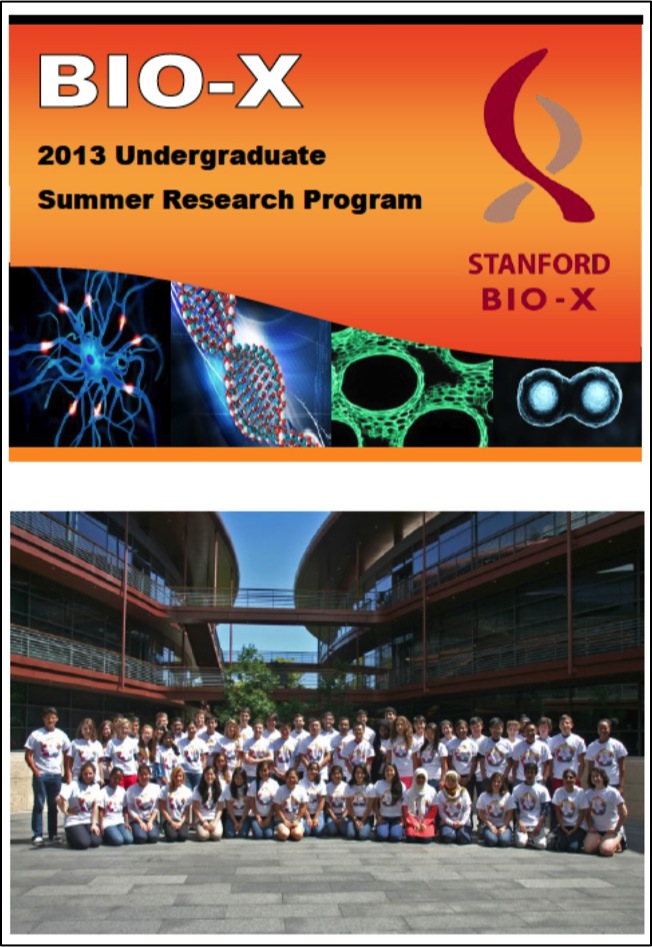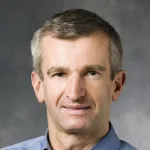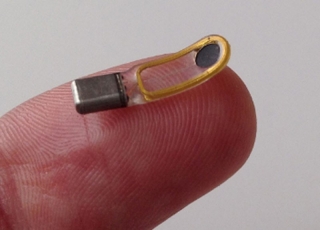
Welcome to the biweekly electronic newsletter from Stanford Bio-X for members of the Bio-X Corporate Forum. Please contact Dr. Hanwei Li, the Bio-X Corporate Forum Liaison if you would like to be added or removed from this distribution list, or if you have any questions about Stanford Bio-X or Stanford University.
Highlights
** On October 9, 2013, Bio-X celebrated the 10th Anniversary of the James H. Clark Center, the hub of Bio-X. Check out CLARK CENTER @ 10X as well as the Bio-X Timeline over the last 15 years!!
** Check out the article by Stanford President John Hennessy in the Nov/Dec 2013 issue of the Stanford Magazine on Bio-X and the Clark Center, "A Cauldron of Innovation".
Bio-X Core Programs
 SEED GRANTS FOR SUCCESS - Stanford Bio-X Interdisciplinary Initiatives Program (IIP) SEED GRANTS FOR SUCCESS - Stanford Bio-X Interdisciplinary Initiatives Program (IIP)The Bio-X Interdisciplinary Initiatives Program represents a key Stanford Initiative to address challenges in human health. The IIP awards approximately $3 million every other year in the form of two-year grants averaging about $150,000 each. From its inception in 2000 through the fifth round in 2010, the program has provided critical early-stage funding to 114 different interdisciplinary projects, involving collaborations from over 300 faculty members, and creating over 450 teams from five different Stanford schools. From just the first 5 rounds, the IIP awards have resulted in a 10-fold-plus return on investment, as well as hundreds of publications, dozens of patents filed, and most importantly, the acceleration of scientific discovery and innovation. 2014 is the start of the 7th round of the Bio-X IIP Seed Grants Program, and 22 newly awarded projects were selected from 142 Letters of Intent (LOIs)! This has been the largest number of LOIs that Bio-X has received. Please go here to check out the newly awarded projects. Competition was intense, and the selection criteria included innovation, high-reward, and new interdisciplinary collaborations. (To view the 142 other IIP projects that have been funded from the previous 6 rounds, please click here.) |
 Bio-X FELLOWSHIPS Bio-X FELLOWSHIPSEvery year, graduate students and postdoctoral scholars of Bio-X affiliated faculty are highly encouraged to apply for the Bio-X Fellowships, which are awarded to research projects that are interdisciplinary and utilize the technologies of different fields to solve different biological questions. Students are encouraged to work collaboratively with professors of different departments, thus creating cross-disciplinary relationships among the different Stanford schools. Our fellows have conducted exciting research, resulting in publications in high-impact journals and have been offered excellent positions in industry and academia. To date, with the 19 new awardees of 2014, Stanford Bio-X has a total of 173 Fellows. You can view the numerous Fellowship projects that have been awarded over the years as well as oral presentations from previous symposiums here. |
 Bio-X UNDERGRADUATE SUMMER RESEARCH PROGRAM Bio-X UNDERGRADUATE SUMMER RESEARCH PROGRAMThe Bio-X Undergraduate Summer Research Program supports undergraduate research training through an award designed to support interdisciplinary undergraduate summer research projects. The program is an invaluable opportunity for students to conduct hands-on research, learn how to carry out experiments in the laboratory, and develop the skills to read and analyze scientific literature. This program is eligible to Stanford students who want to work in the labs of Bio-X affiliated faculty. To date, with 65 new awardees from 154 applications submitted this year, 306 students have been awarded the opportunity to participate in the Bio-X Undergraduate Summer Research Program. Participating undergraduates are also required to present poster presentations on the research that they've conducted during the program. Please click here for title lists of past posters that our undergraduates have presented. |
We are cultivating and are highly successful in building meaningful collaborations with numerous corporate colleagues. New collaborations through our core programs are highly encouraged. To learn about how to get involved, please contact Dr. Hanwei Li, or Dr. Heideh Fattaey.
Bio-X also holds symposiums every year that highlight our core programs. The latest one was on August 27, 2014, where over 300 people attended Bio-X's latest Interdisciplinary Initiatives Seed Grants Program Symposium. There were 8 different oral presentations from faculty members who were awarded Bio-X Seed Grants on the progress that they have made with the funding towards their projects. In addition, Bio-X had its largest poster session ever with 167 posters presented during the reception of the symposium! If you'd like to learn more about any of the projects that were presented during the entire symposium, please contact Dr. Hanwei Li with your questions.
News
 New insights into how the brain stays bright
New insights into how the brain stays bright
Bio-X Affiliated Faculty Axel Brunger
Axel Brunger, PhD, professor and chair of Stanford’s Department of Molecular and Cellular Physiology , and a team composed of several Stanford colleagues and UCSF scientists including Yifan Cheng, PhD, have moved neuroscience a step forward with a close-up inspection of a brain-wide nano-recycling operation. A healthy adult brain accounts for about 2 percent of a healthy person’s weight, and it consumes about 20 percent of all the energy that person’s body uses. That’s a lot of sugar getting burned up in your head, and here’s why: Incessant chit-chat throughout the brain’s staggeringly complex circuitry. A single nerve cell (of the brain’s estimated 100 billion) may communicate directly with as many as a million others, with the median in the vicinity of 10,000. To transmit signals to one another, nerve cells release specialized chemicals called neurotransmitters into small gaps called synapses that separate one nerve cell in a circuit from the next. The firing patterns of our synapses underwrite our consciousness, emotions and behavior. The simple act of tasting a doughnut requires millions of simultaneous and precise synaptic firing events throughout the brain and, in turn, precisely coordinated timing of neurotransmitter release.

 Telomere extension turns back aging clock in cultured human cells, study finds
Telomere extension turns back aging clock in cultured human cells, study finds
Bio-X Affiliated Faculty Helen Blau, Juan Santiago, and 2010 Bio-X Skippy Frank Fellow Jennifer Brady
Project supported by Bio-X IIP Seed Grant Program
A new procedure can quickly and efficiently increase the length of human telomeres, the protective caps on the ends of chromosomes that are linked to aging and disease, according to scientists at the Stanford University School of Medicine. Treated cells behave as if they are much younger than untreated cells, multiplying with abandon in the laboratory dish rather than stagnating or dying. The procedure, which involves the use of a modified type of RNA, will improve the ability of researchers to generate large numbers of cells for study or drug development, the scientists say. Skin cells with telomeres lengthened by the procedure were able to divide up to 40 more times than untreated cells. The research may point to new ways to treat diseases caused by shortened telomeres. Telomeres are the protective caps on the ends of the strands of DNA called chromosomes, which house our genomes. In young humans, telomeres are about 8,000-10,000 nucleotides long. They shorten with each cell division, however, and when they reach a critical length the cell stops dividing or dies. This internal “clock” makes it difficult to keep most cells growing in a laboratory for more than a few cell doublings. “Now we have found a way to lengthen human telomeres by as much as 1,000 nucleotides, turning back the internal clock in these cells by the equivalent of many years of human life,” said Helen Blau, PhD, professor of microbiology and immunology at Stanford and director of the university’s Baxter Laboratory for Stem Cell Biology. “This greatly increases the number of cells available for studies such as drug testing or disease modeling.”
 Stanford bioengineers develop tool for reprogramming genetic code
Stanford bioengineers develop tool for reprogramming genetic code
Bio-X Affiliated Faculty Lei Stanley Qi
Biology relies upon the precise activation of specific genes to work properly. If that sequence gets out of whack, or one gene turns on only partially, the outcome can often lead to a disease. Now, bioengineers at Stanford and other universities have developed a sort of programmable genetic code that allows them to preferentially activate or deactivate genes in living cells. The work is published in the current issue of Cell, and could help usher in a new generation of gene therapies. The technique is an adaptation of CRISPR, itself a relatively new genetic tool that makes use of a natural defense mechanism that bacteria evolved over millions of years to slice up infectious virus DNA. Standard CRISPR consists of two components: a short RNA that matches a particular spot in the genome, and a protein called Cas9 that snips the DNA in that location. For the purposes of gene editing, scientists can control where the protein snips the genome, insert a new gene into the cut and patch it back together. Inserting new genetic code, however, is just one way to influence how the genome is expressed. Another involves telling the cell how much or how little to activate a particular gene, thus controlling how much protein a cell produces from that gene and altering its behavior. It's this action that Lei Stanley Qi, an assistant professor of bioengineering and of chemical and systems biology at Stanford, and his colleagues aim to manipulate.
 Environment, not genes, plays starring role in human immune variation, study finds
Environment, not genes, plays starring role in human immune variation, study finds
Bio-X Affiliated Faculty Mark Davis
A study of twins conducted by Stanford University School of Medicine investigators shows that our environment, more than our heredity, plays the starring role in determining the state of our immune system, the body’s primary defense against disease. This is especially true as we age, the study indicates. Much has been made of the role genes play in human health. Stunning advances in gene-sequencing technologies, in concert with their plummeting costs, have turned many scientists’ attention to minute variations in the genome — the entire toolbox of genes carried in virtually every cell in the body — in the hope of predicting people’s future health. Such studies have revealed a genetic contribution to health outcomes. But, with some notable exceptions, very few individual genetic variants contribute much to particular health conditions. “The idea in some circles has been that if you sequence someone’s genome, you can tell what diseases they’re going to have 50 years later,” said Mark Davis, PhD, professor of microbiology and director of Stanford’s Institute for Immunity, Transplantation and Infection. But while genomic variation clearly plays a key role in some diseases, he said, the immune system has to be tremendously adaptable in order to cope with unpredictable episodes of infection, injury and tumor formation. “The immune system has to think on its feet,” said Davis, senior author of the new study, which will be published Jan. 15 in Cell. Lead authorship is shared by former Stanford postdoctoral scholars Petter Brodin, MD, PhD, and Vladimir Jojic, PhD.
 A real tear-jerker: Team creates device to alleviate dry eye
A real tear-jerker: Team creates device to alleviate dry eye
Feature on device created by a Stanford Biodesign fellow mentored by Bio-X affiliated faculty Mark Blumenkranz and Daniel Palanker
Michael Ackermann, PhD, knows how to make you cry. But this is a good thing for the more than 20 million Americans who suffer from a painful condition in which the lacrimal glands don’t create enough tears to lubricate the surface of the eye. To help these patients, Ackermann, PhD, a former Stanford Biodesign fellow, and his new company are testing two tiny devices that stimulate natural tear production by delivering micro-electrical pulses to the lacrimal gland. One model is inserted into the mucous membrane in the nasal cavity, and the other is inserted under the skin below the eyebrow. Tear delivery rates can be adjusted manually with a wireless controller. Stanford Biodesign is a training program in medical-technology innovation and development. Each year, it admits 12 applicants with backgrounds in medicine, engineering and business. These Biodesign fellows work to address unmet medical needs through the development of new technologies and devices. Ackermann, 32, who has a boyish grin and buzz-cut hair, joined the program in 2010 after earning a PhD in biomedical engineering from Case Western University and working on chronic-pain and movement-disorder devices at Boston Scientific, a medical device corporation. He said he enjoyed the corporate work but realized he wasn’t a big-company person. “I thought the Biodesign Program was a good opportunity to try out entrepreneurship in a safe, academic environment,” he said.
Events
| Neurology & Neurosciences Feb 2, 2015, 4 pm - 5 pm Munzer Auditorium, Beckman Bldg, Stanford, CA Frontiers in Aging Seminar Series: Mouse models for aging biology Speaker: Toren Finkel, PhD, NIH |
Biochemistry Feb 4, 2015, 4 pm - 5 pm Clark Auditorium, Stanford, CA Frontiers in Biology: Neuronal mechanisms and programs regulating alternative pre-mRNA splicing Speaker: Douglas Black, UCLA |
Resources
| Stanford University |
| Stanford Bio-X |
| Bio-X Seed Grants The Stanford Bio-X Interdisciplinary Initiatives Program (IIP) provides seed funding for high-risk, high-reward, collaborative projects across the university, and have been highly successful in fostering transformative research. |
| Office of Technology and Licensing "Techfinder" Search the OTL Technology Portal to find technologies available for licensing from Stanford. |
| Stanford Center for Professional Development - Take advantage of your FREE membership! - Take online graduate courses in engineering, leadership and management, bioscience, and more. - Register for free webinars and seminars, and gets discounts on courses. |
| Stanford Biodesign Video Tutorials on how FDA approves medical devices A series of video briefs recently produced by the Stanford Biodesign Program teaches innovators how to get a medical device approved for use in the United States. This free, online library of 60 videos provides detailed information on the Food and Drug Administration regulatory process, short case studies and advice on interacting with the FDA. |
To learn more about Stanford Bio-X or Stanford University, please contact Dr. Hanwei Li, the Bio-X Corporate Forum Liaison, at 650-725-1523 or lhanwei1@stanford.edu, or Dr. Heideh Fattaey, the Executive Director of Bio-X Operations and Programs, at 650-799-1608 or hfattaey@stanford.edu.

